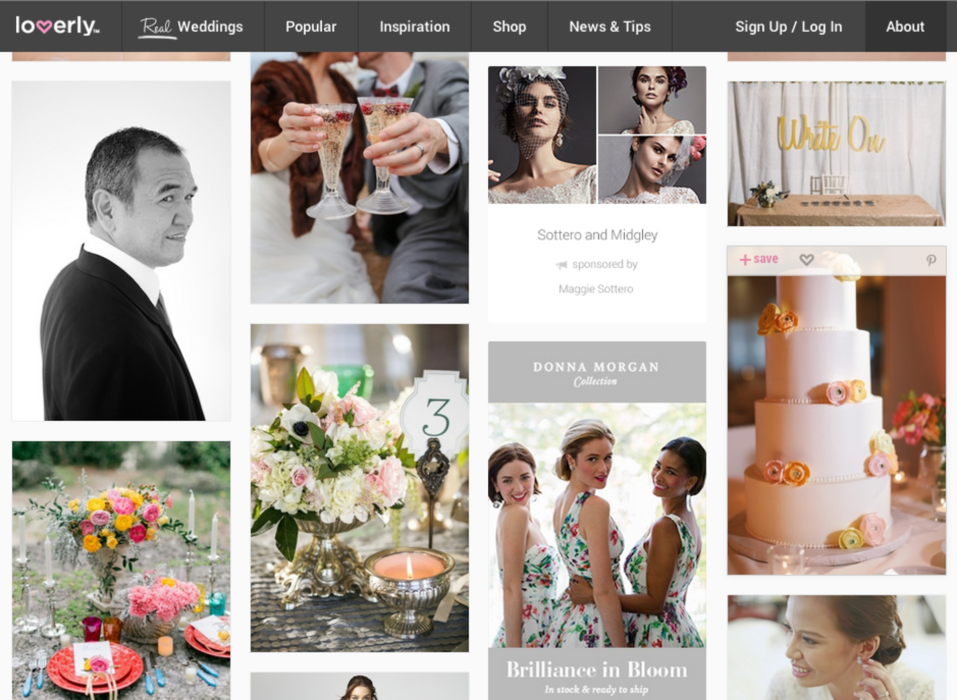After a rocky start—think of the scoffs that the word “advertorial” can provoke—native advertising is blossoming as a way for companies to connect prospects and customers. Loverly (lover.ly), a wedding-planning platform, is one company using the oft-debated approach to forge meaningful marriages between its users and advertisers.
Loverly’s native advertising approach helped its advertiser Donna Morgan more than double its average click-through rate (CTR), according to Kathleen McFeeters, the bridesmaid dress-design company’s CEO and founder. “As an advertiser, it allows us to create highly targeted content based on the bride’s user experience data,” McFeeters says, “rather than just serving her a generic brand ad.”
That targeting and clarity is noteworthy at a time when the term “native advertising” still generates confusion among many marketers and consumers. Fifty percent of respondents to a 2014 survey on native advertising by marketing firm Copyblogger were not familiar with term. “My suspicions are confirmed that native advertising is an ambiguous advertising model,” writes Copyblogger Media’s Demian Farnworth.
B2B companies tend to be more certain about the value and use of native advertising. For example, Big 4 auditing and consulting firm Deloitte’s how-to guidance for chief financial officers and corporate finance executives in The Wall Street Journal’s online “CFO Journal” section reads very much like a CFO magazine or WSJ article.
Pictures, not pitches
Loverly’s approach is different—its advertisers are tightly woven directly into the site’s primary content offerings: a heavy dose of images (think Pinterest) of everything from wedding dresses to tableware accompanied by a clearinghouse of curated posts and articles by many of the most well-read wedding bloggers and publications. Imagine if Amazon’s heuristics were focused exclusively on the items you buy for yourself in a single category (e.g., nonfiction books or gardening supplies), and its search results for products were paired with interesting articles and alluring photos (that you could “pin”) on those topics. This guidance-focused, photo-heavy content is married to a wide range of wedding-related advertisers—including key partners such as David’s Bridal, Dessy, Donna Morgan, Pas de Deux Bridal, Wedding Paper Divas, and World Kitchen—via Loverly’s data analysis. In addition to content (clearly called out as sponsored) woven into the main image pages, these advertisers have customized brand profile pages, featuring their newest products, sweepstakes, or content, on Loverly’s platform.
The photos are a key component of the site; in fact, site visitors view roughly 40 million images a month. Loverly has been tagging these images for the past three years. Analyses of the tags and related user data helps Loverly see connections between content types and providers; for example, “connections between photographers, florists, and planners,” says Loverly COO and President Peggy Fry. Loverly collects data about which vendors are associated with each image. Additionally, it asks users to share their role in the wedding, the wedding date, wedding theme, colors, and the like. It also monitors usage behavior throughout each site visit (e.g., clicks, searches, shares, and “bundles”). Bundles are collections of photos, products, advice, and ideas that users save and can share publically on the site, or with friends, family, and wedding planners. Some users maintain more than 50 different bundles, which present more—and more relevant—opportunities for them to go to the brand profile pages of the vendors in whose offerings they’ve expressed interest.
Better display ads, too
The breadth of data doesn’t just help Loverly’s advertisers serve up the right native ads; it also helps the site present relevant display ads. Insight from the site’s combined data “makes us the most informed wedding platform in the industry,” Fry asserts, adding that it allows the company to serve brides and other users with the right ad at the right time.
Vendors’ ads “are now customized to [a user’s] preferences, color choice, likes, wedding products, and inspirations that will drive conversion and click-through,” says Donna Morgan’s McFeeters, who reports that the brand profile pages and bundling functionality has specifically increased Donna Morgan’s average CTR by 105%. And that’s nothing to scoff at.






